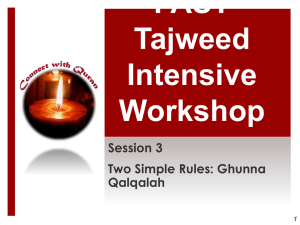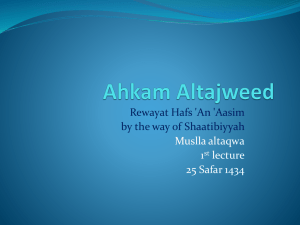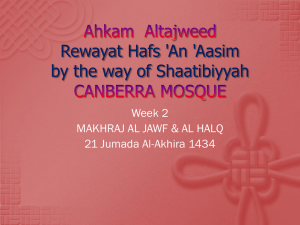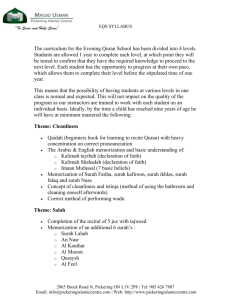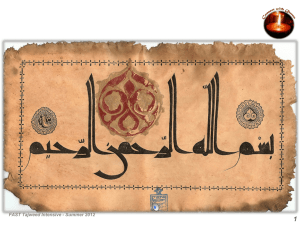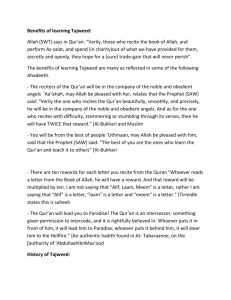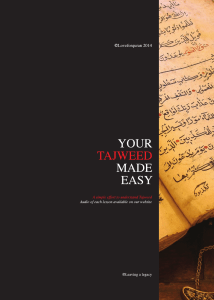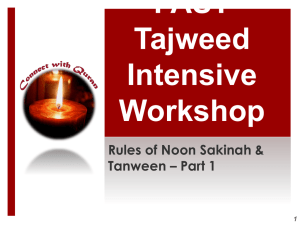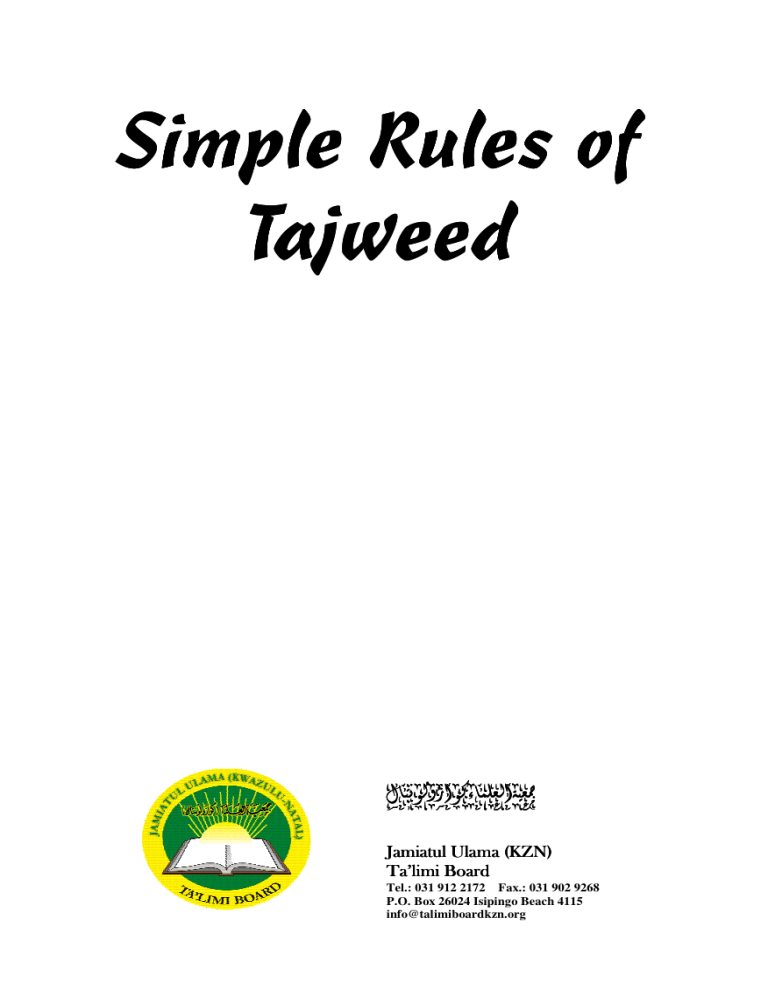
Simple Rules of
Tajweed
ßbnäíÜ잌aíØöbáÝÉÜaóïÉ»
Jamiatul Ulama (KZN)
Ta’limi Board
Tel.: 031 912 2172 Fax.: 031 902 9268
P.O. Box 26024 Isipingo Beach 4115
info@talimiboardkzn.org
Simple Rules of Tajweed
Title:
Published by:
Jamiatul Ulama (KZN)
Ta’limi Board
4 Third Avenue
P.O.Box 26024
Isipingo Beach
4115
South Africa
Tel:
Fax:
E-mail:
Website:
Skype:
+27-31 912 2172
+27-31 902 9268
info@talimiboardkzn.org
www.talimiboardkzn.org
talimiboard
First edition:
Second edition:
Third edition:
Zul Hijjah
1423 /February 2003
Ramadhaan
1429 / September 2008
Rabi-us-Thaani 1431 / April
2010
For the Esaale - Sawaab of the entire Ummah of Nabi j
1.
2.
3.
Open permission is granted for reprinting of this booklet provided that it is not for personal
gain and no alterations are made.
A humble appeal is directed to readers to offer suggestions, corrections, etc. to improve
the quality of this publication in the future. May Allah Ta’ala reward you for this.
The author, sponsors and typesetter humbly request your duas for them, their parents,
families, Asaatidha and Mashaaikh.
Contents
Introduction……………………………………...............................................
1
Makhaarij / Special letters……………………………………………………………..
2
Full mouth letters…………………………………………………………………………..
3
Open & Closed letters…………………………….……………………………………..
4
Ghunnah……………………………………………………………………………………..…
5
Idghaam………………………………………………………………………………………..
6
Ikhfa………………………………………………………………………………………….…
8
Izhaar…………………………………………………………………………………………....
9
Rules of Meem……………………………………………………………………………...
10
Qalb……………………………………………………………………………………………...
11
Rules of Raa…………………………………………………………………………………..
12
Laam of Allah………………………………………………………………………………... 13
Qalqalah………………………………………………………………………………………..
14
Symbols of waqf……………………………………………………………………………. 16
The rules of waqf (STOPPING)……………………………………………….…….… 17
Mudd............................................................................................... 19
Simple rules of tajweed
Page 1
Introduction
Tajweed literally means to adorn and beautify. In the context of the
recitation of the Quraan Shareef, tajweed refers to the correct
pronunciation of the letters and applying the various rules of
recitation.
The importance of Tajweed cannot be overemphasized. The
recitation of the Qur’aan Shareef in salaah is compulsory. Often, due
to not reciting the Qur’aan Shareef with Tajweed, the salaah is
affected. It is therefore necessary to learn Tajweed so that the
Qur’aan Shareef may be recited correctly.
Arabic is a very delicate language. A slight mispronunciation can
completely change the meaning. The word Qalb means heart. If the
Qaaf in Qalb is not pronounced correctly and instead, it is
pronounced as a kaaf, the meaning changes to “dog!” In Surah
Kausar the word “wan Har” means sacrifice. If the Haa is not
pronounced correctly the meaning changes to “scold!” It is thus
obvious that the rules of Tajweed must be applied in the recitation
of the Qur’aan Shareef.
There are many detailed laws of tajweed which take a long time to
study. However this booklet contains the most basic laws which, if
learnt thoroughly, will enable a learner on the Maktab level to recite
the Quraan Shareef correctly. It must nevertheless be remembered
that the correct application of the rules of tajweed depends upon
listening to its application by someone who has learnt how to
recite the Qur’aan Shareef with Tajweed. Thus the teacher must
clearly recite the various examples to the children, highlighting the
particular rule that is being applied therein. The children must then
be made to repeatedly practice the examples in the book with
additional examples from the Qur’aan Shareef in order to fully grasp
the application of the rule.
Simple rules of tajweed
Page 2
Makhaarij
(Correct pronunciation of letters)
Special letters
Do not confuse the letters in the first row with the similar
sounding letters in the second row.
Simple rules of tajweed
Page 3
Full mouth letters
These seven letters will always be read with a full mouth.
#" )
!
( " () * +,
.) ! " /0
% & '
!
7 45 "6
8"
1 23 )/#
1 + " 0/8
1+( )/=)
9 :* ; <
>&
C
? 4@ 6
* A
B/@)
" C
H
" ED F B FGD ')
7 +4'
F I,J
B 3 & HC
K G )/L & A
J
"%/G A
" G )/-)
/
* +"6
Simple rules of tajweed
Page 4
Open letters
M
C Pull the letter for the duration of one Alif
N; OD )9
D
D
QOP
R
/; ) S )
& " L& " H
" U* # א
9WV OP
& " )& " /; )/.X
F IY+4D 2
F L
W +# D 4 2Z [
Closed letters
Be careful not to drag a closed letter
" LB
\
N; +4_ 7` B C
" I0
/6 [
7]0 [
+^
* H N)
N; 23 2 1 +L /6 "N4]2
a 0 1 b * #
c 7d
Simple rules of tajweed
Page 5
Ghunnah
Whenever Noon or Meem has a Tashdeed, make Ghunnah
(a long nasal sound).
/(40 eNA
"
\P
e fIb /
Ib c
N_
N"X /(6
/I) WD)
/(P/0
" B/I)
/(40
/(8
f)/(8 /6 C g I5" )/L
1"4hV " Y)
/;P/0 F Pi /() /Pi B/; I) C
"NjP& " 4dI)C 3e (G "6 /
I) 1 6
Simple rules of tajweed
Page 6
Idghaam
If after noon saakin
letters
(c)
or tanween
(ek )
C > c M appear then make idghaam
the
(join the
letters) and make ghunnah (a long nasal sound). For e.g.
l" & ".2 1 6
If after noon saakin or tanween the letters
l B
appear
then join the letters and do not make ghunnah.
For e.g.
e C " B c3" ) 1 6
eN+8 B m
"l& ".2 1 6 " no 2 1 6 7(]2 1 (0
p :* 2 *k q
fO@ " P 1 6
e e fdA
/P f46/_
2 r h6& 2
" B3" "N^3 2SP 1 40
e f(_ /P r h6& 2
Simple rules of tajweed
/6 k aQ6
Page 7
n6 1 6
3 V 6 1 6
]^
" l & ^" /6 [
U* ; @ "6 /kOG" A
s )C 1 6
3)C /6C 3 ) C C
N tBC 1 6
M3 ; 2C *k +Q^
* " 2 ci C
/."45 2 c
* o " 2 1 6
/H/0"BC /k(=D _
e3+u 6 3e +( 8 f6/+.) >& 2 C k fI])
Simple rules of tajweed
Page 8
Ikhfa
IKHFAA: If any of the following letters appear after Noon
Saakin or Tanween, Ikhfaa (a nasal sound equal to one alif)
should be made.
m
v w
1 _
N;" 4]u 0 7 +u ` 1 6 N; Ha A
k " k " " x+q gOP NX f4+) NYPJ c/VPi
y
;) k B/P
fL/^ f+A
/P
" 3 G " H r h6& 2
& b" 1 6
R4".X 1 6
e f( + ey"Y^"
Simple rules of tajweed
Page 9
Izhaar
If any of the following letters come after a Noon Saakin or
Tanween, Izhaar will be made.
:
Izhaar means to recite without a nasal sound
(without pulling).
& # 1 6
m
*G P C
R(]PJ
" WI6
y
', 16 16 J 1 6
eN+j 8 eN+4_
7+L/L *k +z eN+4_ F q
*k +, /k6& *e +d# eN+4_ /I23 /8k & " P
" B 1 6 c r D c
N+) % r _ 1 6 Nj
Simple rules of tajweed
Page 10
Rules of Meem
IDGHAAM: If a Meem appears after Meem Saakin, ghunna
will be made.
"
F I6 NjI+H/2
/6 Nj" )
"Nj]6 N;" P
c& " 4` * "6 Nj" +)
IKHFAA: If a Baa appears after Meem Saakin, Ikhfa will be
made
N; L N;" LB
1 +I6 { "(L N" /6C
"N;I+L Nj" 8/
0
D L N E/
Y]2
IZHAAR: If any letter besides Baa and Meem appears after
Meem Saakin, do not make ghunna.
e*b J N;" 40
F 0 N"3 +^ 7]u 2 N)J Nj" " I2 Nj" )
Simple rules of tajweed
Page 11
Qalb
If the letter % appears after Noon Saakin or Tanween, Qalb
will be made. Qalb means that the Noon or Tanween will
change into a >
3 ]L 1 ۢ 6 1 ; H& " +"L 1 ۢ 6
7+}t* ` F~ IL 1 ۢ 6
75 L 1 ۢ 6
/;4.L 1 ۢ 6
f+A
/I)/L ۢ /k]OV I) /(L ۢ 3k LJ /(L gۢ OP
ۢ
e
L 1h(@ "6
c /(2Z/
WL *e ۢ @ OI"6
I+L /
ۢ 2א
/
* @ L ۢ f2* N; YIV )/L ۢ /+)
fI+L 1 ۢ _
Simple rules of tajweed
Page 12
Rules of Raa
Raa with a Fatha (Zabar) or Dhammah (Pesh)
OR
Raa Saakin with a Fatha or Dhamma before it
will be read with a Full Mouth.
N; +6 * H 7` B C
k*+z
*H N)
c& " * " 2
" BZ R
^"
* "6 C
* %
* L
F LB
Raa with a Kasrah or Raa Saakin with a Kasrah before it will
be read with an Empty Mouth.
N"Br P * q 1 6 * +# 1 6
* Y C
/P B/P F 0 %
* A
B & z" C
* d)/L
"Br"P
* YP/0
% * q
* ^3 "6
Simple rules of tajweed
Page 13
Laam of Allah
If a Dhammah (Pesh) or Fatha (Zabar) comes before the
word “Allah”, it will be read with a Full Mouth (Tafkheem).
" ED & "
D" E Z
P
ED *" -
" ED NY#
ED l" & `" B
ED F4_
" ED F B
If a Kasrah (Zer) comes before the word “Allah”, it will be
read with an Empty Mouth (Tarqeeq).
ED F0
ED N V L
ED 3" (G )J
ED 3 I_ 1 6
" ED 7 " DE /L " & "_J
ED /
2אL
Simple rules of tajweed
Page 14
Qalqalah
b
If any of the letters of (3
"y@ " )
w % has a
saakin or jazam, Qalqalah will be made. Qalqalah means
to make an echoing sound.
"I.2
*.L
"N;(]z J e fIh(@ "6
e7d8
*e dA
*e u0
"NV "
k fO@ " P
72* db
" * u H
M
s ]b *)
3.) 3 )& " 2 N)C 3 42 N) e B3 /P3 d_ /I4]u H N;" Y4d ! .P
Simple rules of tajweed
Page 15
The same rule applies if the Saakin is due to Waqf (stopping).
K4#
yC
K40
y;)
e & " Ij )
e38 J
"
"
w C*d) ` /L
we S 6
B
eK2* 8
& " ]"
"3(-)
"K8
yV ^
"6
e +G
we * 8
w C *" " L
Take care: When making Qalqalah, take care that a Harkat
should not be read
(Zabar, Zer or Pesh) is not created. e7d8
as
e7d8
Simple rules of tajweed
Page 16
Symbols of Waqf (Stopping
(Stopping)
topping)
﴾﴿ > [ These signs indicate that you must
stop.
ۤ
ۡ
ۡ
ۡ 'ﻣﺎ
ۡ ۡ
ﻞ ﺑ ٖﻪ ﻛﺜ
ﲑ
ﻳﻦ ﻛﻔﺮ' ﻓﻴ ﻘﻮﻟﻮ! ﻣﺎ ﷲ ﺑ ٰﻬﺬ ﻣﺜﻼ ﻳﻀ+
.
ۡ
ۡ
ۡ ۡ
ﺑ ٖﻪ ﻛﺜ1
﴾﴿ ﻞ ﺑ ٖﻪۤ ﻻ ﻟ ٰﻔﺴﻘﲔ
'ﻳﻬﺪ
'ﻣﺎ ﻳﻀ0 ﲑ
w 7A These signs indicate that you have
the option to stop.
ۡ
.
ٰ ﻣ ۡﻦ ﻇﻬ ۡﻮﻫﺎ 'ﻟ:ﺒﻴ ۡﻮ.! ﺗﺎۡﺗﻮ ﻟ. ﱪ ﺑﺎ.'ﻟ=ۡﺲ ﻟ
'ﺗﻮ4ﱪ ﻣﻦ ﺗ ٰﻘﻲ
ﻟ
ﻦ
ﻜ
.
.
. 'ﺗﻘﻮ ﷲ ﻟﻌ ﻠB ﻮﺑﻬﺎ.ﻦ ﺑ. ﻣ:ﻟﺒﻴ ۡﻮ
!ﺤ ۡﻮ
ﻜﻢ ﺗﻔﻠ
fOC fYj` These signs indicate that a slight
pause should be made without
breaking the breath.
.
ۡ
ۡ
.
. .
.
Mﻮ. ﻟﻘNﺮﻧﺎ ﻋ. ﻨﺎ ﻓﺎﻧﺼLٰ ﻮﻟ. ﻧﺖ ﻣE ﺣﻤﻨﺎ
' E ﺮ ﻟﻨﺎ. 'ﻏﻔE ﻒ ﻋ ﻨﺎ
'ﻋ
ٰ .
ﻟﻜﻔﺮﻳ ۡﻦ
Z
Do not stop.
ۡ
. ﺒﻠ. ﻳۡﻦ ﻣ ۡﻦ ﻗ+
' !ﻮ. ﺮﻋ. ﻓRٰ Sﻛﺪ
P
Simple rules of tajweed
Page 17
Rules of Waqf (Stopping
(Stopping)
topping)
1. The general rule of waqf is to remove the harkat of the
last letter and replace it with a sukoon / jazam.
p :& ) 9 :* +,
K 40
yV ^ "7`" " B y
; )
3e 8 :& ) :* +,
K 40
yV ^ 7`" " B
y; )
3 8 2. If the last letter has a fathatain / do zabar, take out one
fatha / zabar and read the alif after it.
(If there isn’t an alif, add one).
k tS b k t3 P
*k o P k a+4 /kL/V 8
*k V " 2
/k(+( 8
tS b t3 P
* o P a+4 /L/V 8
* V " 2
/(+( 8
3. If the last letter is a round taa , change it to a (small) haa
and put a sukoon / jazam on it.
k U* .L k f+6 /8 f+)/_ e U* ^r H e fOb B f+q /,
k fIb
:* .L W+6 /8 W+)/_ :* ^r H WOb B W+q /,
WIb
Simple rules of tajweed
Page 18
4. If the last letter is an alif with a fatha / zabar before it or
if the last letter has a sukoon / jazam or the last letter has
a fatha muqaddara / khara zabar, no change will take
place when making waqf.
* +`" //` //IL /a H
FD4 FuD ` * o 8" * +`" //` //IL /a H
FD4 FuD ` * o 8" 5. If , , comes before the last letter, then pull slightly
when making waqf.
2* " & # 1 +]YV P e B& j" q c/+L 1" D(8 *) m
~ 2* " &~ # 1 ~ +]YV P B&~ j" q cn+L 1 ~D(8 *) m
6. If the last letter has a tashdeed, pull a little when making
waqf.
"6 g 6 e7@ 0 y
"*O6 ecb " 8 B'
H
*O6 cb 8 B'
"6 g6 7@ 0 yH
Simple rules of tajweed
Page 19
Mudd
There are two types of Mudd: 1. Short Mudd 2. Long Mudd
Short Mudd - Pull for 3 Alifs
Long Mudd - Pull for 5 Alifs
N;" H b
" o 2 1 6
k V P
72 t* ` s~ IL
nI+Hא
lא
N"YP/~D
~p WXBC
GD h`D
R
t* ."O4)
1 D Y63 "6
K" G ) b
g D 2
" :&D L
" 8
s P& b
" ED א
"
%t
C3) *q 1 2* ^r) D 7
]D+;D ^
!
K V _ N8D
ٓ
ٓ
ۤ
ۤ
W
W
ٰ
ٰ
0 T ﻫ ﺆﻻX 'ﻻT ﻫ ﺆﻻX ﻻ
ۡ ۤ
ﷲT ۡ'! ﻻ ! [ ﺸﺂT' ﻣﺎ \ﺸﺂ
Simple rules of tajweed
Page 20
Notes
